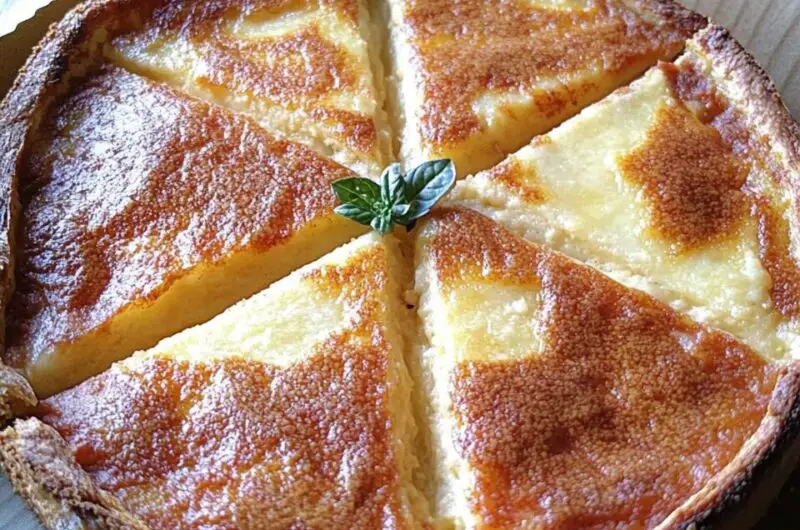This golden-crusted delicacy is a hallmark of Neapolitan Easter celebrations: Pastiera Napoletana. A rich, sweet pie combining creamy ricotta, aromatic wheat berries, floral orange blossom water, and colorful candied citrus peel, all encased in a delicate lattice crust. The perfume of orange and cinnamon is unmistakable it’s like springtime wrapped in pastry. More than just a dessert, Pastiera is a symbol of family tradition, renewal, and Southern Italian heritage. Originally prepared by nuns in Naples during Holy Week, this pie has become a culinary ritual passed down through generations. Letting it rest overnight allows the flavors to mingle beautifully, making it taste even better the next day.
Full Recipe:
Ingredients:
For the shortcrust pastry:
-
2 ½ cups (300g) all-purpose flour
-
1/2 cup (100g) sugar
-
1/2 cup (115g) unsalted butter, cold and cubed
-
2 eggs
-
1 tsp grated lemon zest
-
Pinch of salt
For the wheat filling:
-
1 cup (200g) cooked wheat berries (grano cotto)
-
1 cup (250ml) whole milk
-
1 tbsp unsalted butter
-
1 tsp grated lemon zest
For the ricotta filling:
-
1 ¾ cups (400g) ricotta cheese
-
1 cup (200g) sugar
-
3 eggs
-
1 egg yolk
-
1 tsp orange blossom water
-
1 tsp cinnamon
-
½ cup (75g) candied citrus peel, finely chopped
-
Grated zest of 1 orange
Directions:
-
Begin by preparing the shortcrust pastry. Combine flour, sugar, lemon zest, and salt in a bowl. Cut in the cold butter until the mixture resembles crumbs. Add the eggs and knead briefly to form a dough. Wrap in plastic wrap and refrigerate for 1 hour.
-
In a saucepan, combine the cooked wheat berries with milk, butter, and lemon zest. Simmer over low heat until creamy, about 10-15 minutes. Let cool.
-
In a separate bowl, mix the ricotta with sugar until smooth. Add eggs one at a time, followed by the yolk, orange blossom water, cinnamon, orange zest, and candied citrus peel. Mix in the cooled wheat mixture.
-
Preheat the oven to 350°F (175°C).
-
Roll out 2/3 of the chilled pastry and line a greased 9-inch springform or deep tart pan. Fill with the ricotta-wheat mixture.
-
Roll out remaining dough and cut into strips. Lay them over the filling in a crisscross lattice pattern.
-
Bake for about 60 minutes, or until golden and set. Allow to cool completely before serving. For best flavor, let rest overnight.
Prep Time: 1 hour (plus chilling) | Cooking Time: 1 hour | Total Time: 2 hours
Kcal: 450 kcal | Servings: 8
A Bite of History in Every Slice
Few desserts encapsulate the spirit of a holiday the way Pastiera Napoletana does for Easter in Naples. This traditional Italian pie, rich with wheat berries, ricotta cheese, and the ethereal scent of orange blossom water, is not just a treat it’s a culinary time capsule.
Pastiera has roots that reach deep into the ancient cultures of Southern Italy. Many food historians believe its origins are intertwined with pagan springtime rituals, celebrating rebirth and fertility. The use of wheat, a symbol of life and prosperity, can be traced back to Roman times, when it was offered to Ceres, the goddess of agriculture.
Later, the Catholic tradition embraced this dish, integrating it into Holy Week preparations. Legend has it that Pastiera was first baked by Neapolitan nuns in a convent, who wanted to create a dessert that symbolized the resurrection. They blended ingredients representing life, love, and spirituality wheat for rebirth, eggs for fertility, ricotta for purity, and the floral essence of orange blossom for the blooming season.
Why Pastiera Is So Special
Unlike typical cakes or pies that you bake and eat the same day, Pastiera Napoletana is a dessert of patience and ritual. It’s traditionally made on Maundy Thursday or Good Friday and left to rest for at least 24 hours often more before being served on Easter Sunday. This resting period is not just tradition, it’s essential: it allows the flavors to marry and mellow, transforming into a uniquely fragrant and balanced dessert.
The texture is another aspect that makes Pastiera stand out. The filling is smooth yet grainy from the softened wheat berries, which lend a slightly chewy contrast to the creamy ricotta. The crust is tender but sturdy enough to support the generous, custard-like interior. And the flavor? A complex medley of sweet, creamy, citrusy, and spicy, punctuated by candied fruit and perfumed by orange blossom.
Symbolism in Ingredients
Each component of Pastiera Napoletana is steeped in symbolism:
-
Wheat berries: Symbolize rebirth, the cycle of life, and the spring season.
-
Ricotta: Represents purity, innocence, and simplicity an echo of spiritual renewal.
-
Eggs: A universal symbol of life and resurrection, perfectly aligned with Easter themes.
-
Orange blossom water: Not only evocative of Mediterranean gardens in bloom, but also believed to have calming and uplifting properties.
-
Candied citrus peel: A nod to the festive nature of Easter, and a way to preserve the brightness of fruit year-round.
Together, these ingredients create more than a dessert they tell a story.
A Recipe Passed Down Through Generations
In Neapolitan households, the making of Pastiera is a cherished family ritual. Recipes are often handwritten, annotated with changes over decades, and passed from nonna to madre to nipote. Each family has its own twist some use a splash of liqueur, others swear by a specific ricotta brand, while a few insist that only homemade candied citrus will do.
In many homes, it’s not just one pie being baked it’s several. Neighbors trade slices, families gift them to friends, and kitchens fill with the heady scent of vanilla, cinnamon, and orange blossoms as ovens run non-stop.
Modern Twists vs. Tradition
While tradition remains strong, contemporary chefs and home bakers have introduced modern variations to the classic pastiera. Some lighten the filling by folding in whipped egg whites, giving it a more airy texture. Others experiment with different types of grains like farro or barley in place of traditional wheat berries. Vegan adaptations now exist, using dairy-free ricotta alternatives and egg replacements, while gluten-free versions modify the crust and use grains that fit dietary needs.
Still, most Neapolitans will argue that a Pastiera is only authentic when made the old-fashioned way with wheat, ricotta, and time.
Tips for a Perfect Pastiera
Here are a few insights that can help make your pastiera truly memorable:
1. Use High-Quality Ricotta
Fresh ricotta from a reputable dairy is non-negotiable. Avoid overly processed or watery ricotta, which can make the filling soggy. If your ricotta is very moist, let it drain overnight in the fridge.
2. Let the Wheat Mixture Cool
When cooking the wheat with milk and butter, ensure it’s completely cooled before mixing it with the ricotta and eggs. Adding it too soon can scramble the eggs and ruin the filling.
3. Don’t Skip the Resting Time
While it’s tempting to dig in once it cools, Pastiera really needs a full day to develop its full flavor. The filling will firm up and the orange blossom aroma will become more balanced and nuanced.
4. Lattice Is Traditional but Not Mandatory
The classic look features a criss-cross pastry lattice over the top. It’s symbolic of religious motifs and adds visual charm. However, if you’re short on dough or time, you can bake it without it will taste just as heavenly.
Cultural and Festive Relevance
In Naples, the arrival of Pastiera on the Easter table signals more than just dessert it’s a culmination of Holy Week and a promise of new beginnings. It’s also common to see Pastiera in southern Italian pastry shops and bakeries starting the week before Easter. These versions vary slightly from home-baked ones but serve the same purpose: celebrating community, spirituality, and the arrival of spring.
Though it’s strongly tied to Easter, many Neapolitans enjoy Pastiera throughout the spring and even around Christmas, as its comforting and aromatic qualities lend themselves well to festive occasions.
Pairing Suggestions
Pairing Pastiera with the right drink enhances its flavor. A small glass of Limoncello or Vin Santo complements its citrusy notes, while an espresso or cappuccino offers a wonderful contrast to its creamy sweetness. Some even enjoy it with a dry sparkling wine like Prosecco to cut through the richness.
Conclusion:
Pastiera Napoletana is far more than just a pie it’s a reflection of Italy’s culinary depth, its cultural traditions, and its love for symbolic, story-rich food. While it may require more effort and planning than a quick weeknight dessert, the results are well worth it. Baking a Pastiera is like inviting history, family, and the spirit of spring into your kitchen.
Whether you’re Italian by blood or simply by heart, adding this dish to your Easter traditions is a beautiful way to honor one of Italy’s most iconic, soulful, and beloved desserts.







